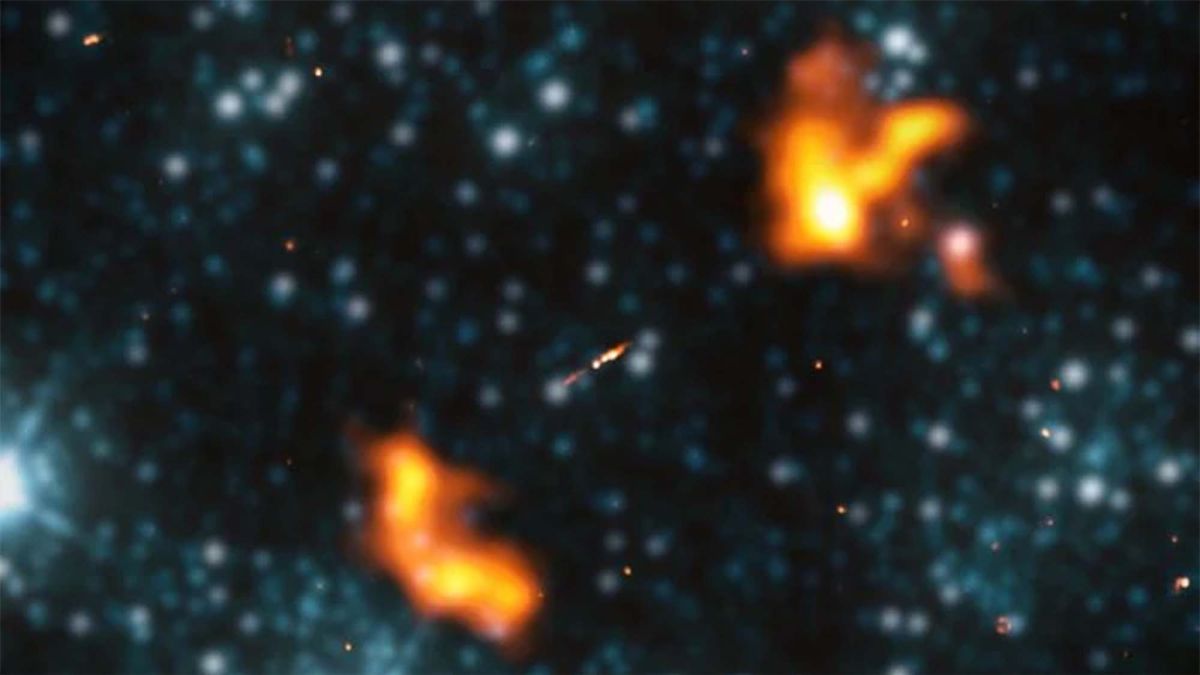Galaxies are mind-bendingly big structures, but one recently discovered galaxy is an absolute colossus stretching millions of light years across despite having less mass than many of its counterparts.
The galaxy in question, Alcyoneus, is a special type of galaxy known as a radio galaxy, defined by a unique feature of its central supermassive black hole.
When any black hole gobbles up material, it does so similar to water swirling down a drain. As water gets closer to the drain, its angular velocity increases considerably.
The same happens to matter as it swirls around a black hole’s event horizon, though the velocity of matter just outside the event horizon can approach significant fractions of the speed of light.
And, sometimes, some of that matter is able to escape being eaten by riding the immense magnetic field of the black hole to the magnetic poles and getting shot out into space as relativistic jets of highly charged particles.
These jets can travel hundreds of thousands of light years before forming into massive lobes. These lobes interact with the intergalactic medium to generate radio emissions, giving this type of galaxy its name.
With Alcyoneus, though, these lobes are absolutely gigantic, extending five megaparsecs from the end of one to the end of the other, which translates to about 16.3 million light years across.

The discovery by researchers at Leiden University in the Netherlands – which was published this week on the preprint server ArXiv and which has been accepted for publication by the journal Astronomy & Astrophysics – may provide astronomers with vital clues to solving the mystery of radio galaxies’ enormous growth.
“Giant radio galaxies (GRGs, or colloquially ‘giants’) are the Universe’s largest structures generated by individual galaxies… However, the main mechanisms that drive their exceptional growth remain poorly understood,” the researchers write in the paper.
Surprisingly, the supermassive black hole at the center of the galactic disk producing the jets and lobes actually isn’t the largest seen to date. In fact, it might be smaller than the median mass of the supermassive black hole at the center of a radio galaxy, and the underlying mass of “host galaxy” isn’t larger than is typically found either, making its gargantuan lobes all that more mysterious.
“The discovery shows that the sphere of influence of some galaxies reaches far from their direct environment,” a Leiden University statement on the discovery said. “How far, exactly? That is hard to determine.”
Even more, we’re only seeing Alcyoneus from a single viewpoint, so it’s very difficult to judge its depth.
“As a result, scientists can only measure a part of the radio galaxy length: a low estimate of the total length,” Leiden University said. “But even that lower bound, of more than 16 million light years, is gargantuan, and comparable to one hundred Milky Ways in a row.”
Analysis: how do you even classify the size of a galaxy?
The relatively ordinary size of the “host galaxy” producing the lobes leads to an interesting question: what does size even mean in this context?
Are relativistic jets and the lobes they produce a part of the galaxy or are they separate from them? Smoke accompanies fire, but we understand the two to be different things, so aren’t relativistic jets and lobes the same thing except on a galactic scale?
The problem with that analogy is the galactic scale, ultimately. The lobes of a radio galaxy are still under the influence of the galaxy that produces them, so they don’t exist independent of it, even if they are millions of light years away.
Complicating things further is that radio galaxies are almost exclusively the product of an elliptical galaxy, which don’t have the familiar shapes of a spiral galaxy.
They also have far less or no new star formation, along with lower levels of gas than brighter, younger, and more active spiral galaxies like our own, so it’s harder to qualify their features the way it is for spiral galaxies.
All of this is to say that there is debate around these classifications, but there’s no denying that Alcyoneus is going to be an important part of that debate going forward.
